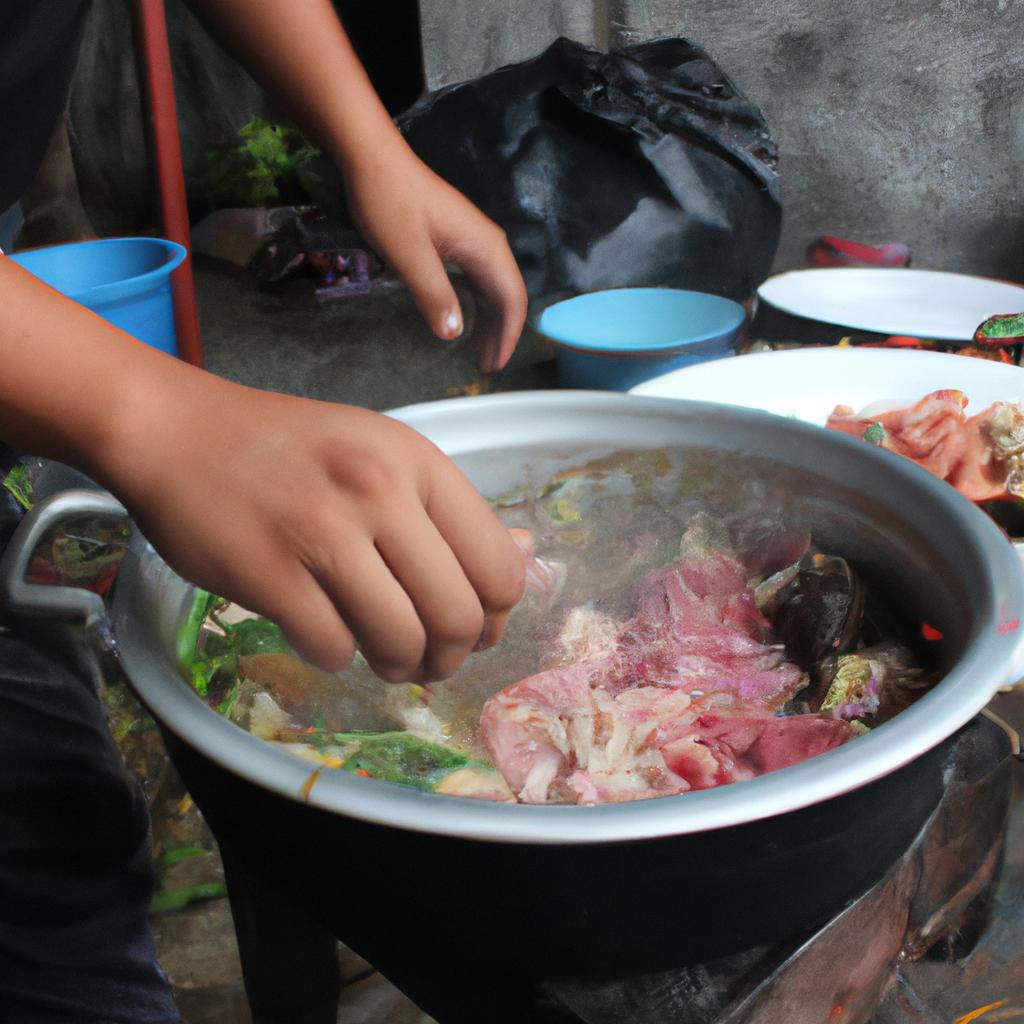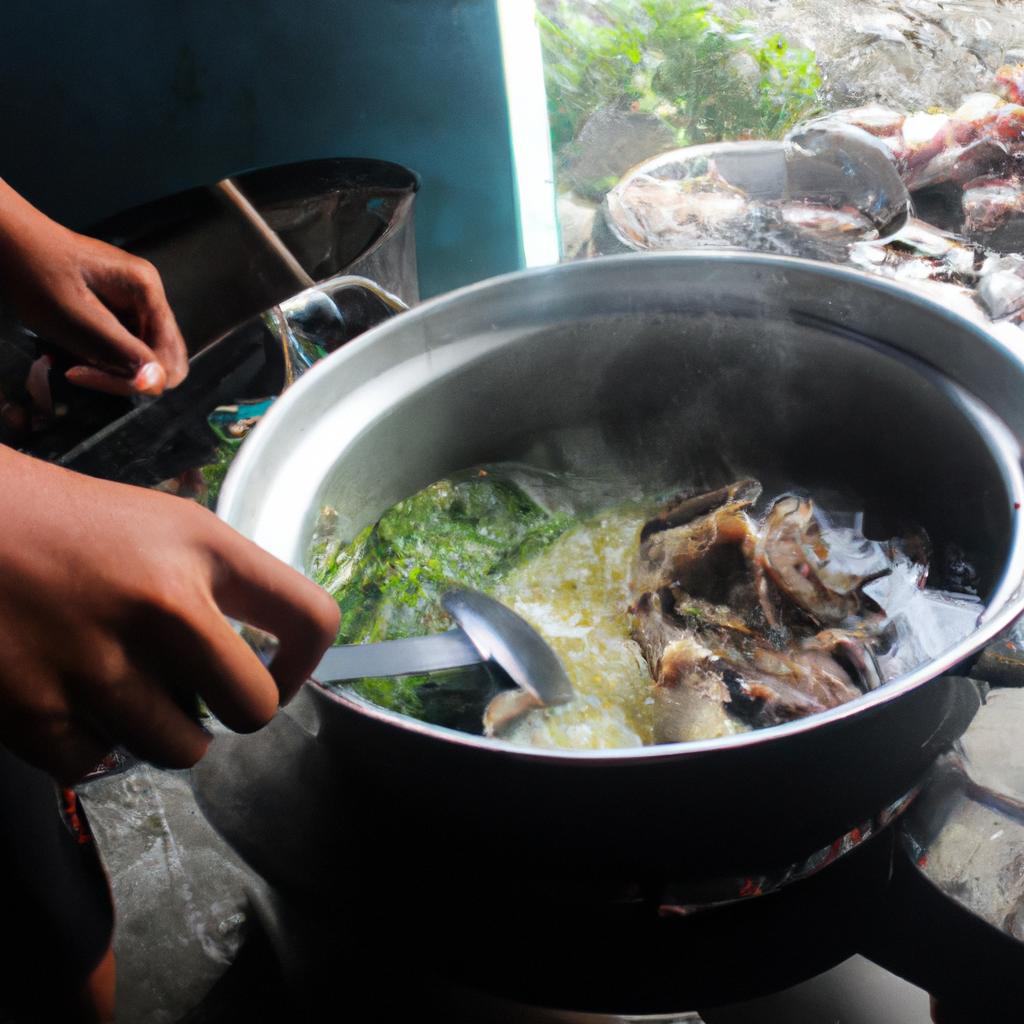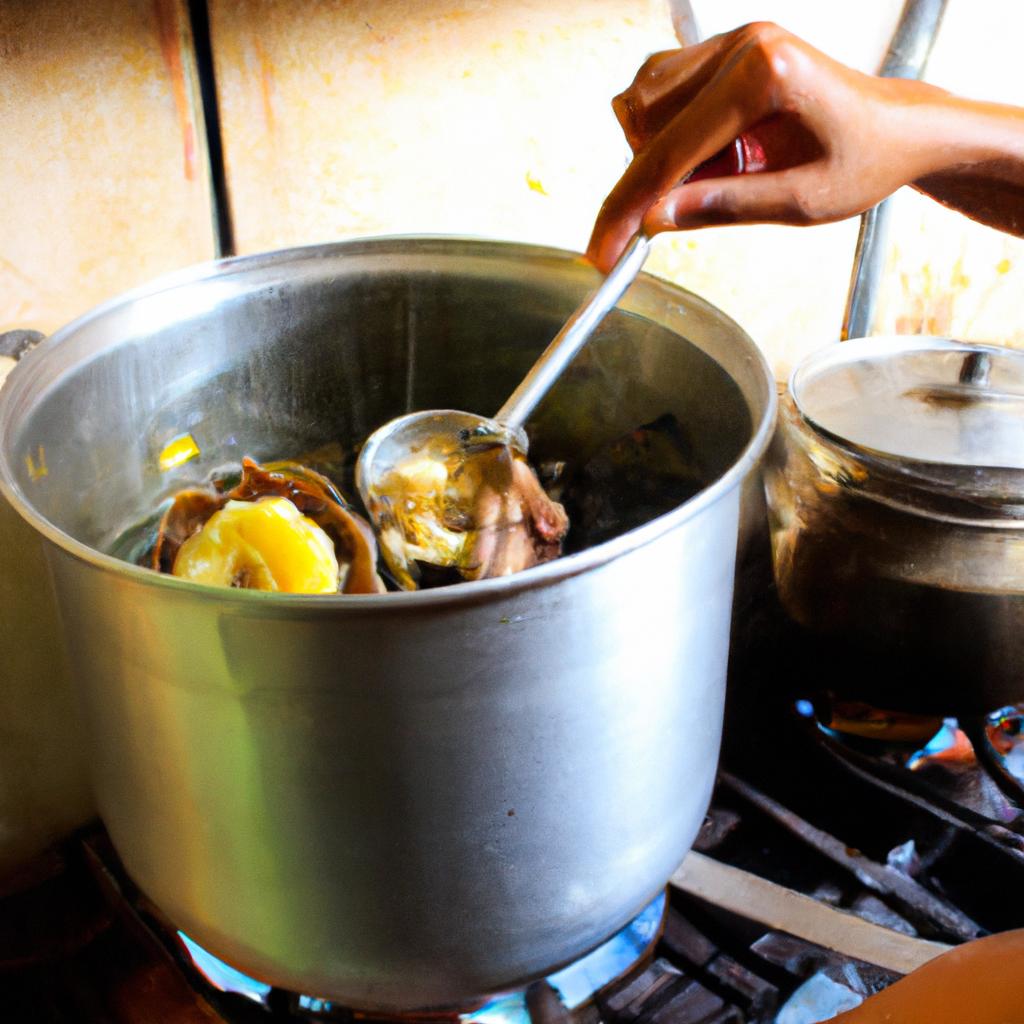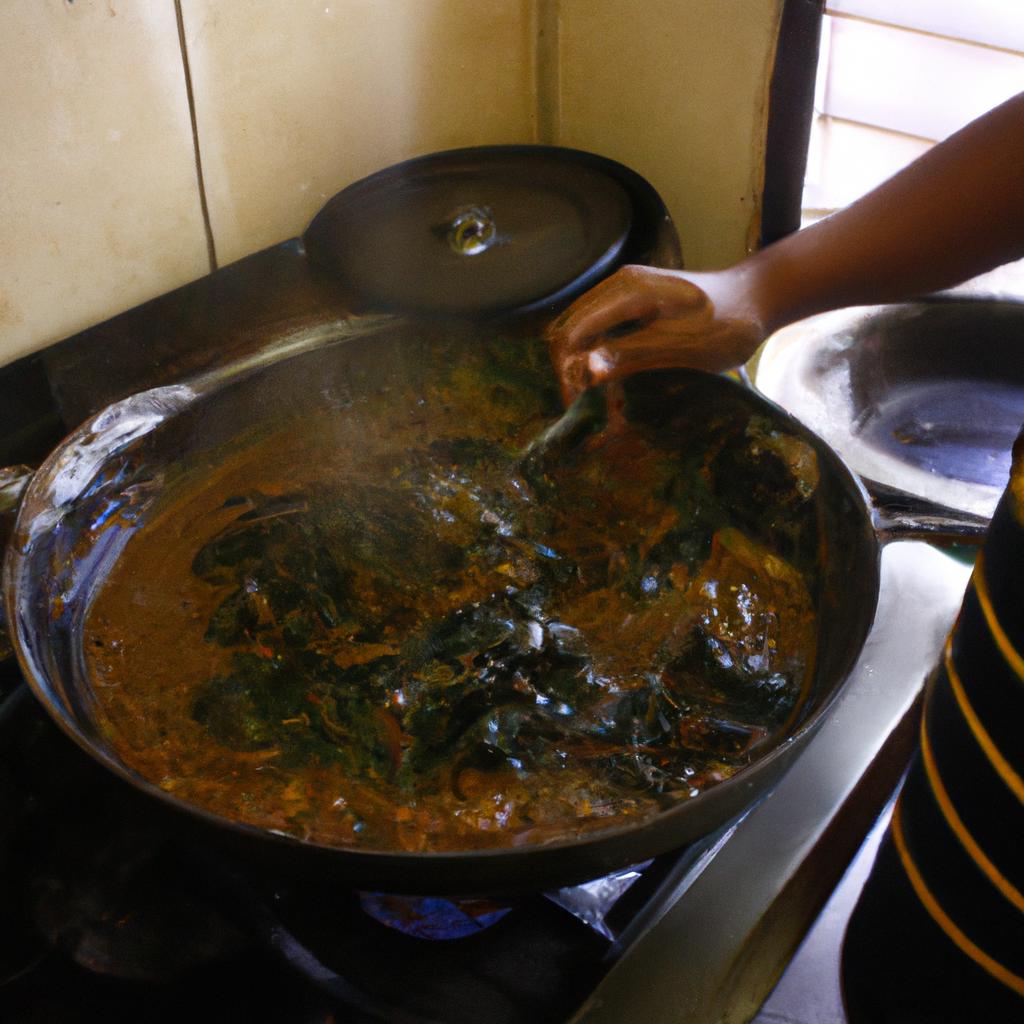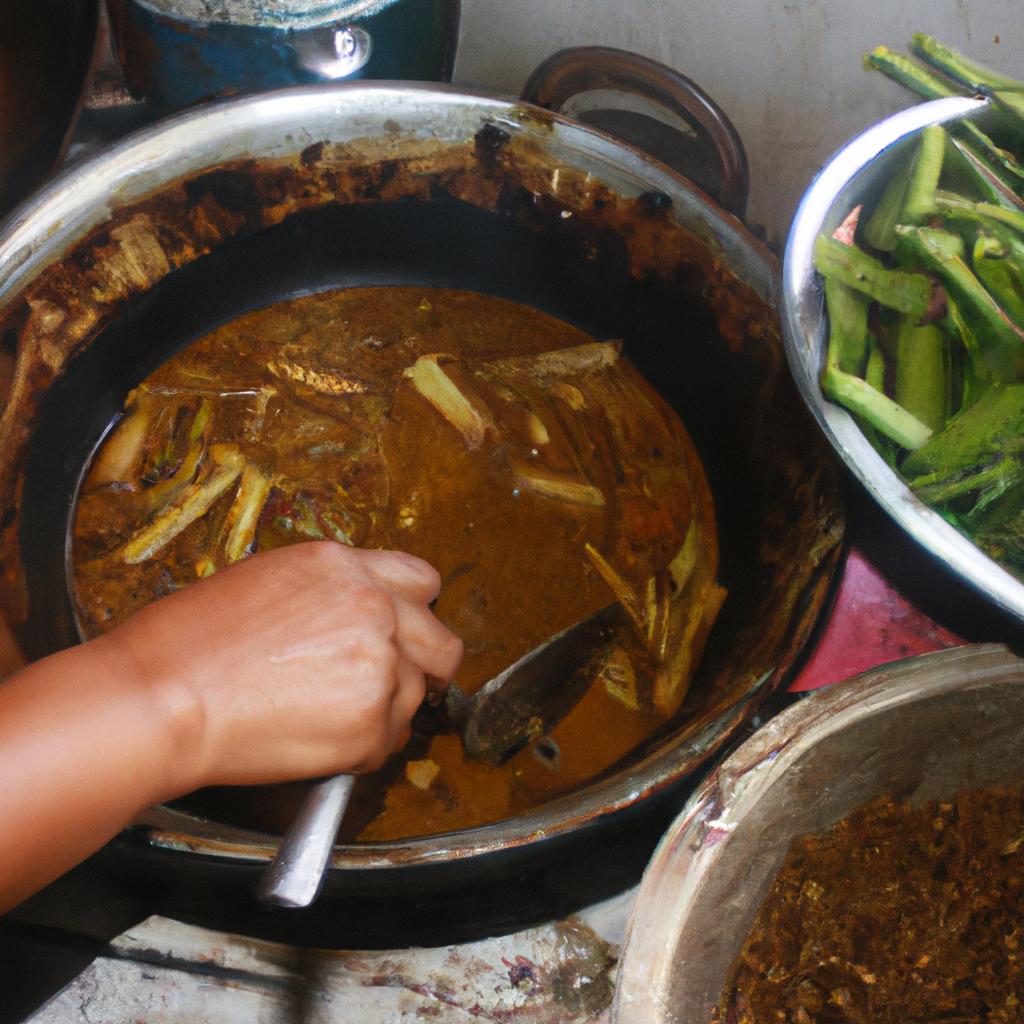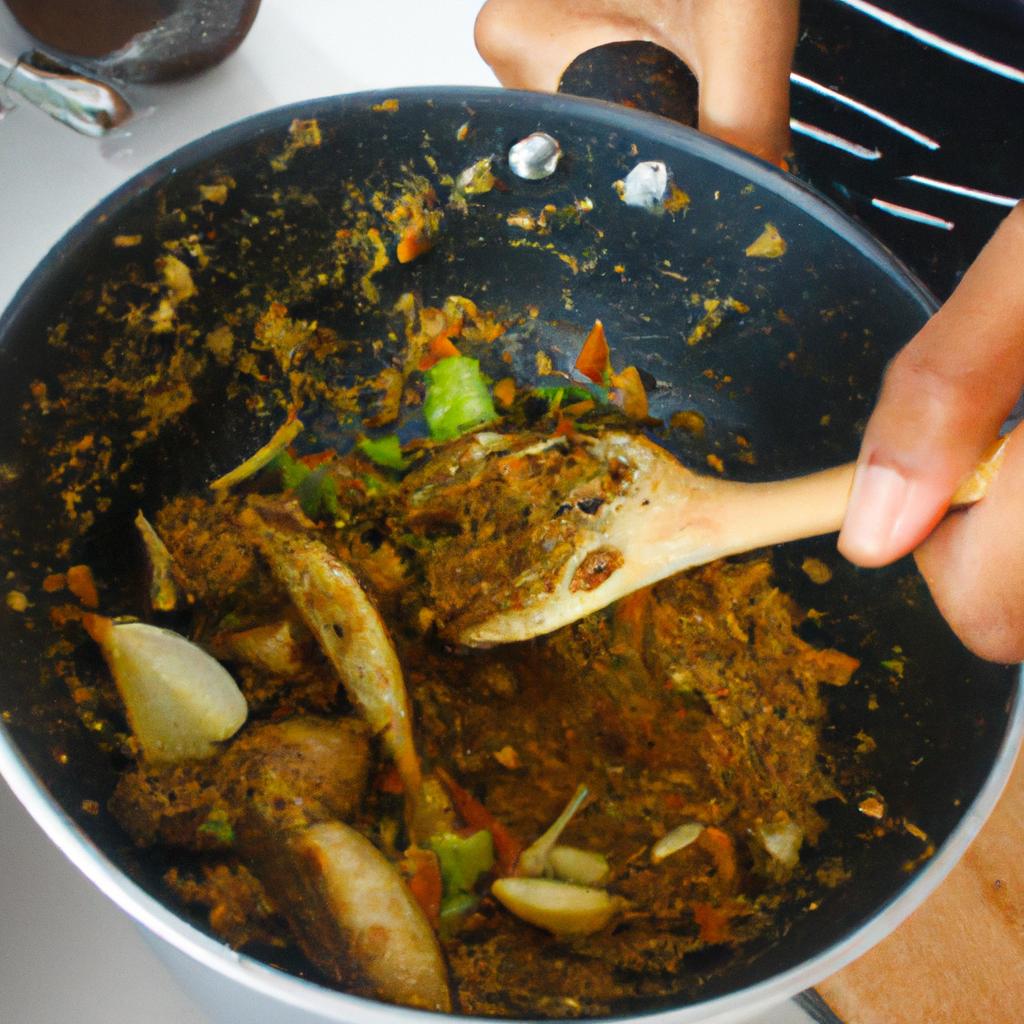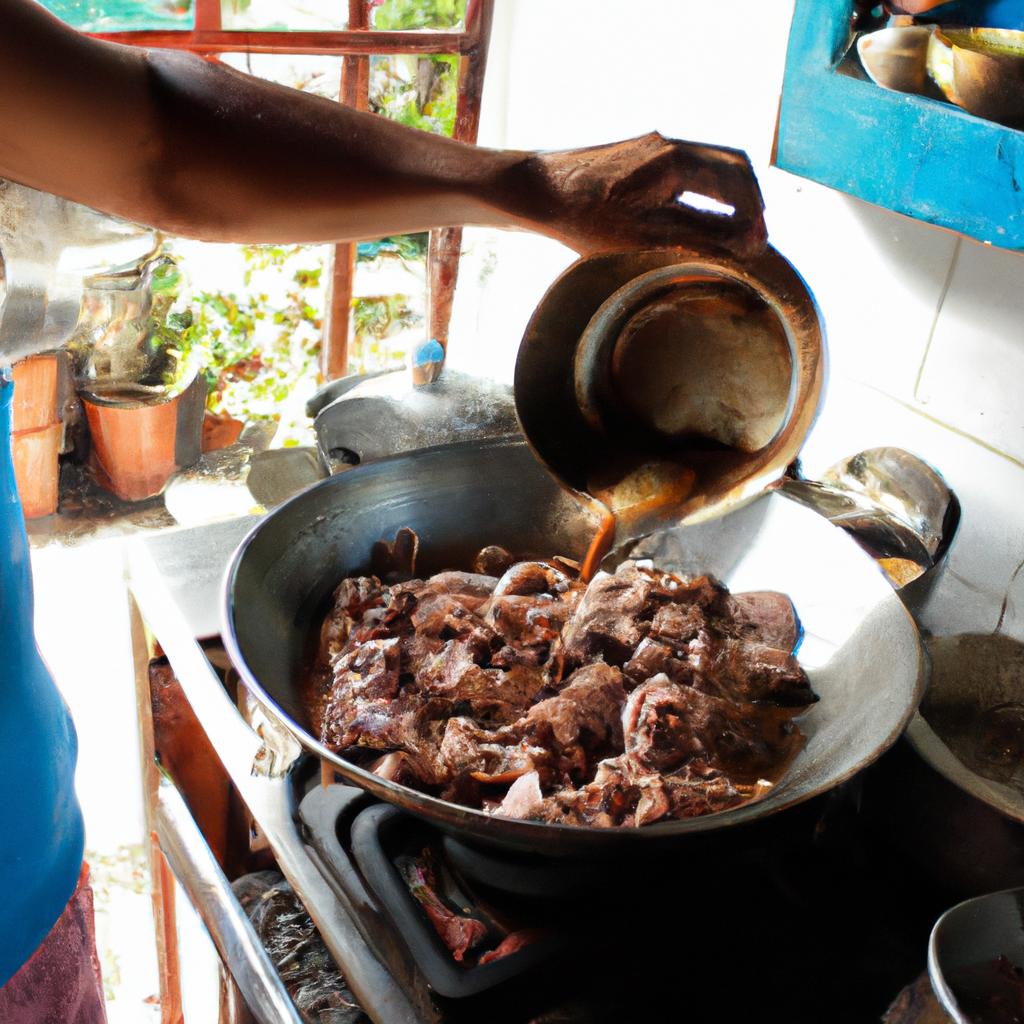Bulalo, a traditional Filipino dish renowned for its delectable flavors and rich cultural significance, has long captivated the palates of locals and tourists alike. This article aims to demystify the intricacies surrounding bulalo by exploring its origins, preparation methods, and key ingredients. By shedding light on this cherished delicacy, readers will gain an in-depth understanding of how bulalo embodies the essence of Filipino cuisine.
To illustrate the allure of bulalo, consider a hypothetical case study: John, a curious traveler visiting the Philippines for the first time, stumbles upon a bustling street food market. Intrigued by the savory aroma wafting through the air, he follows his nose to a small stall where he encounters a steaming pot filled with succulent beef shanks submerged in a hearty broth. The vendor proudly proclaims it as “bulalo,” assuring John that it is an authentic Filipino experience not to be missed. Eager to delve into local culinary traditions, John decides to give it a try.
Origin
Imagine yourself sitting in a bustling Filipino market, surrounded by the aroma of simmering broth and tender chunks of meat. You notice a crowd gathering around a small stall, eagerly waiting for their turn to savor the hearty goodness of bulalo. This popular dish not only satisfies hunger but also tantalizes taste buds with its rich flavors. To fully appreciate this delicacy, it is essential to delve into its origins.
Bulalo traces its roots back to the Philippines, where it has been cherished for generations. It originated in Batangas, a province known for its culinary treasures. In this region, bulalo holds cultural significance and is often served during special occasions or family gatherings. Its popularity eventually spread across the country and became an emblematic dish enjoyed by Filipinos from all walks of life.
To understand why bulalo resonates so deeply with Filipinos, we must explore the emotions associated with this beloved delicacy:
- Comfort: Bulalo’s warm broth comforts both body and soul on rainy days or chilly evenings.
- Nostalgia: The familiar taste of bulalo evokes memories of childhood family meals and reunions.
- Unity: Sharing a steaming pot of bulalo brings people together, fostering bonds over shared experiences.
- Pride: Bulalo represents Filipino culture and heritage, showcasing the country’s unique culinary traditions.
Furthermore, let us consider some key elements that make up a traditional bowl of bulalo:
| Ingredients | Preparation | Served With |
|---|---|---|
| Beef shanks | Slow-cooked | Native vegetables (e.g., pechay) |
| Bone marrow | Simmered | Corn on the cob |
| Onion | Seasoned | Fish sauce |
| Garlic | Garnished | Calamansi juice |
Focusing on quality ingredients like beef shanks and bone marrow adds depth and richness to the broth. Slow-cooking allows flavors to meld together, resulting in a tender meat that practically falls off the bone. Served with native vegetables, corn on the cob, and accompanied by fish sauce and calamansi juice for added zest, bulalo becomes an experience that satisfies both hunger and culinary cravings.
As we explore further into the art of preparing this exquisite dish, let us now turn our attention to its intricate steps without losing sight of its cultural significance.
Preparation
Originating from the Philippines, bulalo is a Traditional Filipino Delicacy that has gained popularity both locally and internationally. This hearty soup dish is known for its rich flavors and tender beef shanks, making it a favorite among locals and tourists alike.
To understand the origins of bulalo, let us take a closer look at one particular case study – a small town in Batangas province, where this iconic dish is said to have originated. In this town, bulalo was initially prepared by boiling leftover bones and meat scraps from various cuts of beef. Over time, the recipe evolved as local cooks began adding vegetables such as corn on the cob, cabbage, and pechay (Chinese cabbage) to enhance the flavor profile. Today, bulalo remains deeply ingrained in Filipino culinary culture and can be found in many restaurants across the country.
The preparation of bulalo involves several key steps to ensure its distinctive taste. Here are some essential aspects:
- Choice of Beef: The quality of beef used greatly impacts the overall flavor of bulalo. Chefs often prefer using beef shanks or marrow bones due to their high collagen content, resulting in a rich and flavorful broth.
- Slow Cooking: Bulalo is typically cooked slowly over low heat for an extended period. This allows the flavors to meld together while ensuring that the meat becomes incredibly tender.
- Skimming Impurities: During the cooking process, impurities may rise to the surface of the broth. Skimming these impurities helps maintain clarity and cleanliness in the final product.
- Seasoning: A balanced combination of salt, pepper, garlic, onions, and other herbs and spices add depth to the broth’s flavor profile.
Bulalo holds a special place in Filipino cuisine because it not only satisfies hunger but also evokes feelings of comfort and warmth. Its aroma alone can transport individuals back to cherished memories with loved ones gathered around a steaming bowl of this delightful soup.
In the subsequent section, we will delve into the traditional recipe for preparing bulalo, providing a step-by-step guide to recreate this Filipino delicacy in your own kitchen. But before that, let us explore the key ingredients and techniques used in making this delectable dish.
Traditional recipe
Transitioning from the previous section, where we explored the intricate process of preparing bulalo, let us now delve into the traditional recipe that has made this Filipino delicacy truly exceptional. To illustrate its appeal, envision a scenario wherein you find yourself in a bustling local eatery in Manila. As you take your seat, a steaming bowl of bulalo is placed before you – rich broth infused with flavorsome bone marrow and tender beef shanks, accompanied by vibrant vegetables and fragrant spices.
To fully appreciate the allure of bulalo, it is essential to understand its key ingredients and preparation techniques. The traditional recipe typically incorporates the following elements:
- Beef shanks: Succulent cuts of meat renowned for their flavorful tenderness.
- Bone marrow: A prized component that enhances the richness of the broth.
- Vegetables: Fresh corn cobs, bok choy, cabbage, and onions add both texture and nutritional value to the dish.
- Spices: Garlic, black peppercorns, bay leaves, salt, and fish sauce come together harmoniously to create an aromatic blend.
| Ingredients | Quantity |
|---|---|
| Beef Shanks | 500g |
| Bone Marrow | 200g |
| Corn Cobs | 2 pcs |
| Bok Choy | 4 stalks |
| Cabbage | 100g |
| Onions | 2 medium-sized bulbs |
| Garlic cloves | 6 pcs |
Imagining each spoonful offers not only a burst of delectable flavors but also evokes feelings of warmth and comfort. The combination of tender meat, nourishing vegetables, and aromatic broth creates an experience that transcends mere sustenance.
Transitioning seamlessly into the subsequent section on ‘Cultural Significance,’ we begin to unravel the layers of history and tradition surrounding this beloved Filipino dish – a culinary gem that has become an integral part of the country’s cultural tapestry.
Cultural significance
Traditional Recipe: Unveiling the Secrets Behind Bulalo
As we delve deeper into the world of Filipino cuisine, it is essential to explore the traditional recipe for bulalo. To better understand its preparation and significance, let us consider a hypothetical scenario involving a family gathering in the heart of Manila.
Imagine a bustling kitchen filled with laughter and anticipation. The matriarch of the family, Lola Maria, skillfully selects beef shanks from the local market. She meticulously trims off excess fat before placing them in a large pot alongside onions, garlic, and peppercorns. With water added generously to cover the ingredients, Lola Maria begins simmering this mixture over low heat for several hours until the flavors meld together harmoniously.
To truly appreciate the Cultural Significance of bulalo within Filipino households, four key elements come into play:
- Nourishment: Bulalo serves as more than just a dish; it is an embodiment of comfort and nourishment passed down through generations. Its rich broth provides warmth during rainy days or when someone falls ill.
- Celebration: Often served on special occasions such as birthdays or anniversaries, bulalo symbolizes abundance and prosperity within Filipino culture.
- Bonding: The act of sharing a steaming bowl of bulalo brings families and friends closer together, fostering meaningful connections and strengthening relationships.
- Tradition: Through preserving and passing down recipes like bulalo, Filipinos maintain their cultural heritage while embracing change in modern times.
In contemplating these aspects surrounding bulalo’s cultural significance, we can gain insight into how deeply rooted this delicacy is in Filipino society.
| Ingredient | Purpose |
|---|---|
| Beef Shanks | Provides richness and flavor |
| Onions | Adds sweetness to the broth |
| Garlic | Enhances overall taste |
| Peppercorns | Offers subtle spiciness |
The table above illustrates the essential ingredients that contribute to the exquisite taste of bulalo. Each element has its unique role in elevating the dish’s overall flavor profile, making it a culinary masterpiece.
As we conclude this exploration of the traditional recipe for bulalo, our next section will delve into the various regional variations that exist throughout the Philippines. By examining these differences, we can appreciate how diverse and dynamic Filipino cuisine truly is.
Transitioning seamlessly into our discussion on “Variations,” let us now explore the myriad ways Filipinos have adapted and personalized this beloved dish across different regions.
Variations
After exploring the cultural significance of Bulalo, it is now time to delve into its various variations. One such variation can be found in the province of Batangas, where they add a unique twist by incorporating green papaya and chili leaves into their Bulalo soup. This combination adds an extra layer of flavor and spiciness that sets it apart from other versions.
When it comes to preparing Bulalo, different regions across the Philippines have their own special way of doing so. Here are some notable variations:
- In Tagaytay City, which is known for its cool climate, restaurants often serve a steaming hot bowl of Bulalong Tahong (Mussels) alongside the traditional beef version. The addition of mussels provides a delightful seafood element to the dish.
- In Pampanga, another region famous for its culinary heritage, locals prepare Sinigang na Bulalo. This variation combines the rich flavors of Bulalo with the tangy notes of sinigang broth, resulting in a mouthwatering fusion dish.
- On the island of Cebu, vendors offer a street food version called “Bulalohan,” where small pieces of bone-in beef shank are grilled over charcoal before being served with dipping sauces like soy sauce and vinegar. This smoky twist on Bulalo offers a unique experience for adventurous eaters.
These regional adaptations showcase not only the versatility but also the creativity within Filipino cuisine. Each variation brings something new to the table while still maintaining the essence and heartiness that make Bulalo so beloved.
To further appreciate this diversity, here’s a glimpse into some emotional responses people have when enjoying these different versions:
- Comfort: The warmth and richness envelop you as you take your first spoonful.
- Nostalgia: Memories flood back as you savor every bite, reminding you of family gatherings or childhood meals.
- Satisfaction: The feeling of contentment as you finish a bowl, knowing that it has satisfied your hunger and warmed your soul.
- Connection: Sharing the experience with loved ones, creating bonds over a shared appreciation for this beloved Filipino dish.
Additionally, here’s a table highlighting some of these variations and their unique characteristics:
| Variation | Region | Additional Ingredients |
|---|---|---|
| Bulalong Tahong | Tagaytay City | Mussels |
| Sinigang na Bulalo | Pampanga | Sinigang broth |
| Bulalohan | Cebu | Grilled beef shank |
As we explore these different versions of Bulalo, it becomes evident that there is more to this Filipino delicacy than meets the eye. The diverse regional adaptations not only showcase culinary creativity but also reflect the rich cultural tapestry of the Philippines. Now, let us delve deeper into the health benefits associated with consuming Bulalo in our next section on Health Benefits.
Health benefits
Section H2: Variations Demystified
Transitioning from the previous section, where we explored the origins and cultural significance of Bulalo, let us now delve into its fascinating variations. To better understand this Filipino delicacy, imagine a scenario where you are dining at a local eatery in Manila. As you peruse the menu, your eyes land upon several enticing options for Bulalo, each with their own unique twist.
One variation that catches your attention is Bulalong Batangas Style. Originating from the province of Batangas in Southern Luzon, this version highlights the use of beef shanks simmered for hours until tender. It is then enhanced by adding corn on the cob, green beans, cabbage, and potatoes to create a hearty and flavorful soup. The combination of these ingredients presents a delightful interplay between rich meatiness and fresh vegetables.
As you continue exploring other variations across different regions in the Philippines, it becomes evident that there are numerous ways to prepare Bulalo while still preserving its essence as a comforting broth-based dish. Here are some popular adaptations:
- Sinigang na Bulalo: This sour soup incorporates tamarind or other souring agents such as calamansi or guava to give an extra tangy kick.
- Kare-kareng Bulalo: In this fusion-inspired rendition, traditional peanut sauce used in Kare-Kare (a Filipino stew) is added to elevate the richness of the soup.
- Paksiw na Bulalo: A thrifty option born out of resourcefulness, leftover Bulalo is cooked with vinegar and various spices to create another delicious dish.
- Tinolang Bulalo: Drawing inspiration from Tinola (a ginger-infused chicken soup), this variant combines the flavors of ginger and fish sauce with tender Beef shanks.
To further engage our audience emotionally here’s a glimpse into how these diverse iterations can evoke feelings of comfort and nostalgia:
- Picture yourself on a rainy day, savoring the warmth of Sinigang na Bulalo’s sour broth that awakens memories of home.
- Imagine enjoying Kare-kareng Bulalo with loved ones during festive gatherings, where the rich peanut sauce brings everyone together in celebration.
- Close your eyes and envision sharing a steaming bowl of Paksiw na Bulalo, its tangy aroma igniting conversations around the table.
Now let us turn our attention to the key ingredients that make up this beloved Filipino dish.
As we explore the variations of Bulalo and their emotional connections, it is crucial to understand the essential components that give this soup its distinct character.
Key ingredients
Bulalo, a traditional Filipino delicacy known for its rich and flavorful broth, has captivated the hearts and taste buds of many. In this section, we will delve deeper into the key ingredients that contribute to the distinctive taste of Bulalo.
One prime example of an essential ingredient in Bulalo is beef shank. This cut of meat contains a significant amount of collagen, which adds thickness and richness to the soup when cooked slowly over low heat. The tenderness of the Beef shank also enhances the overall texture of the dish, making it a delightful experience with every bite.
To further enhance the flavor profile, various vegetables are commonly added to Bulalo. These include corn on the cob, cabbage, bok choy, and green beans – each bringing unique textures and tastes to the dish. The combination of these vegetables not only provides additional nutrients but also contributes to a well-balanced palate that appeals to both locals and foreigners alike.
In addition to its delectable taste, consuming Bulalo can offer several health benefits:
- Rich in protein: Beef shank is a good source of high-quality protein necessary for muscle repair and growth.
- Provides vitamins and minerals: The assortment of vegetables found in Bulalo offers essential vitamins such as vitamin C from cabbage and bok choy, as well as minerals like potassium from corn on the cob.
- Boosts immune system: Garlic, often used as a seasoning in Bulalo broth, contains allicin—a compound known for its antibacterial properties that may help strengthen your immune system.
- Supports bone health: Collagen-rich broth derived from cooking beef bones helps promote healthy bones by providing important nutrients like calcium and phosphorus.
Table – Health Benefits:
| Benefit | Description |
|---|---|
| Protein | Aids in muscle repair and growth |
| Vitamins | Provides essential nutrients like vitamin C |
| Minerals | Offers minerals such as potassium |
| Immune system support | Strengthens the immune system with antibacterial properties of garlic |
| Bone health | Promotes healthy bones through collagen-rich broth |
With its mouthwatering taste and potential health benefits, Bulalo has become a beloved dish in Filipino cuisine. In the following section, we will explore the caloric content of this delightful delicacy and how it can fit into various dietary plans without compromising on flavor or nutritional value. So let’s dive deeper into understanding the caloric aspect of Bulalo.
Caloric content
Transitioning from the previous section on key ingredients, let us delve into another aspect of bulalo: its caloric content. Understanding the nutritional information of this Filipino delicacy can provide valuable insights for individuals seeking to maintain a balanced diet.
To illustrate the significance of caloric content, consider an individual named Maria who is conscious about her daily calorie intake. Maria has decided to have a hearty bowl of bulalo for lunch and wants to understand how it fits into her overall dietary plan. By examining the caloric value per serving size, she can make informed decisions about portion control and balancing her meals throughout the day.
When assessing the caloric content of bulalo, several factors come into play. Here are some key considerations:
- Serving Size: It’s essential to determine if the nutritional information provided aligns with your intended portion size.
- Cooking Methods: Different cooking techniques may affect the caloric content. Grilling or boiling may result in lower fat absorption compared to deep-frying or stewing.
- Ingredients Variations: Depending on personal preferences or regional variations, additional ingredients such as vegetables might be added, impacting the overall caloric value.
- Condiments and Sauces: Accompaniments like soy sauce or chili oil should also be taken into account when calculating total calories.
Now that we’ve explored these factors, let’s examine a table showcasing examples of different types of bulalo along with their estimated caloric values per serving:
| Type of Bulalo | Caloric Content (per serving) |
|---|---|
| Traditional | 400 calories |
| Light Version | 300 calories |
| Vegetable-based | 250 calories |
This table offers an overview of common variations found in bulalo recipes and provides insight into potential differences in calorie counts. Keep in mind that these numbers are approximate estimates and can vary based on specific preparation methods employed by different cooks and restaurants.
Understanding the caloric content of bulalo allows individuals like Maria to make informed choices that align with their dietary goals. By incorporating portion control and balancing it with other nutrient-rich foods, one can enjoy this flavorful delicacy as part of a well-rounded meal plan.
Transitioning into the subsequent section on protein content, let’s explore how bulalo can also provide a significant source of this essential macronutrient.
Protein content
Transitioning smoothly from the previous section on caloric content, let us now explore the protein content of Bulalo, a renowned Filipino delicacy. To illustrate its significance, consider this hypothetical scenario:
Imagine a young athlete named Juanita who is devoted to maintaining her strength and endurance for competitive sports. She seeks out nutritious meals that can fuel her body effectively. One such meal she regularly includes in her diet is a hearty bowl of Bulalo.
Protein plays an essential role in muscle development and repair. As one examines the nutritional profile of Bulalo, it becomes evident why it has gained popularity among fitness enthusiasts like Juanita. Here are some key points to consider regarding the protein content of this delectable dish:
- High protein source: A single serving of Bulalo typically contains around 25 grams of protein, making it an excellent choice for those looking to increase their daily intake.
- Essential amino acids: Protein derived from beef shank – the primary ingredient in traditional Bulalo recipes – provides all nine essential amino acids necessary for optimal bodily functions.
- Slow-release energy: Due to its high-protein composition, consuming Bulalo helps regulate blood sugar levels and promotes satiety throughout the day.
- Nutritional balance: In addition to being rich in protein, Bulalo also offers various vitamins and minerals crucial for overall well-being, including iron, zinc, and B-vitamins.
To provide a visual representation of this information, refer to the following table showcasing the approximate protein content found in different cuts of beef typically used in preparing Bulalo:
| Beef Cut | Approximate Protein Content (per 100g) |
|---|---|
| Shank | 26g |
| Brisket | 24g |
| Ribs | 28g |
| Knuckle | 23g |
As one can see, Bulalo’s protein content primarily relies on the beef cut utilized in its preparation. This diversity allows individuals to choose cuts that align with their dietary preferences and nutritional requirements.
Transitioning into the subsequent section about serving size, it is essential to understand how portion control contributes to a balanced diet without compromising flavor or satisfaction.
Serving size
From the protein-rich goodness of bulalo, we now turn our attention to understanding its recommended serving size. To illustrate this, let’s consider a hypothetical scenario where an individual wants to incorporate bulalo into their daily diet.
When it comes to determining the appropriate serving size for bulalo, several factors need to be taken into account. These include age, gender, activity level, and overall dietary goals. It is important to strike a balance between enjoying the flavorsome dish while ensuring that it aligns with one’s nutritional needs.
To help you make informed decisions about your portion sizes when indulging in this delightful Filipino delicacy, here are some guidelines:
- Consider your calorie requirements: Depending on whether you are trying to maintain or lose weight, you may need to adjust your serving size accordingly.
- Assess your protein intake: Bulalo is already rich in protein content; therefore, if you have consumed sufficient amounts from other sources throughout the day, smaller portions may be appropriate.
- Listen to your body: Pay attention to feelings of fullness and satiety during and after consuming bulalo. This will help gauge if you have had enough or require more.
| Gender | Sedentary Lifestyle (calories) | Active Lifestyle (calories) |
|---|---|---|
| Male | 2,200 – 2,800 | 2,800 – 3,200 |
| Female | 1,800 – 2,000 | 2,000 – 2,400 |
In conclusion of this section dedicated to exploring serving sizes for bulalo consumption within a balanced diet plan tailored towards individual needs and preferences without compromising flavor satisfaction.
Moving forward into the next section about “Garnishes and condiments,” we delve deeper into enhancing the taste profile of bulalo through various accompaniments that complement its savory essence.
Garnishes and condiments
Garnishes and Condiments: Enhancing the Bulalo Experience
Imagine yourself sitting at a bustling Filipino restaurant, eagerly awaiting your bowl of steaming bulalo. As it arrives before you, adorned with an array of vibrant garnishes and accompanied by tantalizing condiments, your senses are instantly heightened. The artful presentation and carefully selected accompaniments not only add visual appeal but also enhance the overall flavor profile of this beloved Filipino delicacy.
To truly appreciate the diverse flavors that accompany bulalo, let us explore some common garnishes and condiments found in many Filipino households and restaurants:
-
Lime or Calamansi Wedges: A squeeze of tangy lime or calamansi juice over the hot broth provides a refreshing burst of acidity, balancing out the richness of the beef marrow. This zesty addition adds brightness to each spoonful.
-
Fish Sauce (Patis): Known as the umami powerhouse of Filipino cuisine, fish sauce lends depth and complexity to the bulalo broth. A few drops can elevate the savory notes, creating a more robust flavor experience.
-
Chili Peppers: For those seeking an extra kick, sliced chili peppers can be added to customize the level of spiciness in bulalo. Whether mild or fiery-hot, these peppers awaken taste buds and contribute to a satisfyingly bold eating experience.
-
Spring Onions (Scallions) and Cilantro: These aromatic greens provide freshness while imparting their unique herbal profiles into every bite. They lend both visual appeal and subtle nuances to complement the meaty essence of bulalo.
In order to fully understand how these garnishes and condiments enhance the enjoyment of bulalo, consider the following sensory journey:
| Sensory Aspect | Enhancement |
|---|---|
| Visual Appeal | Vibrant colors create an appetizing presentation |
| Taste | Balance between rich flavors and bright acidity |
| Aroma | Fragrant herbs and spices add depth to the overall experience |
| Texture | Crunchy chili peppers contrast with tender beef chunks |
The combination of these garnishes and condiments transforms bulalo from a simple soup into a multi-dimensional culinary adventure. Each element contributes its own unique qualities, elevating the dish to new heights.
As you savor your next bowl of bulalo, take the opportunity to experiment with different combinations of garnishes and condiments. Discover which ones resonate most with your palate, allowing you to create a personalized experience that truly showcases the versatility of this Filipino delicacy.

